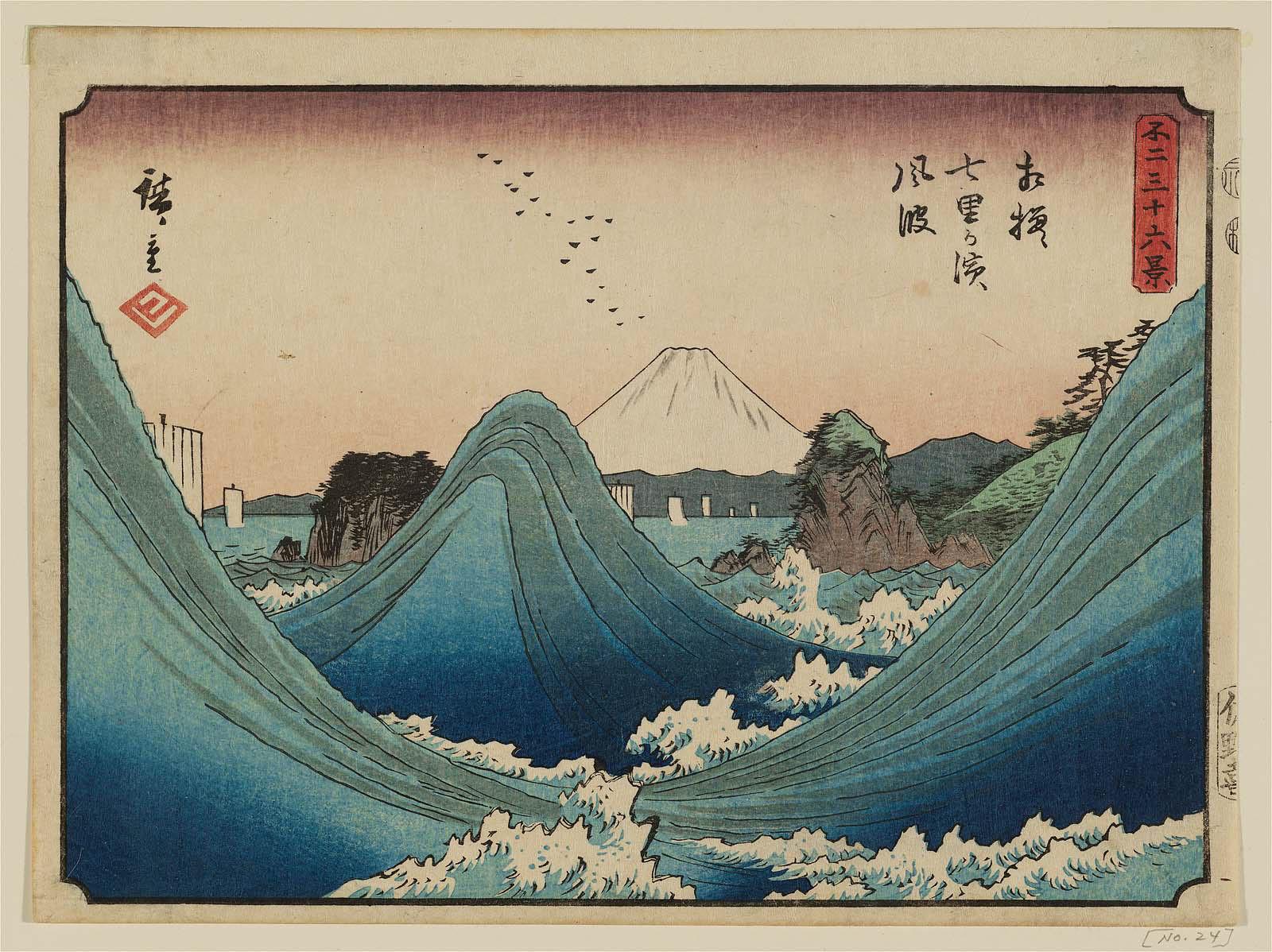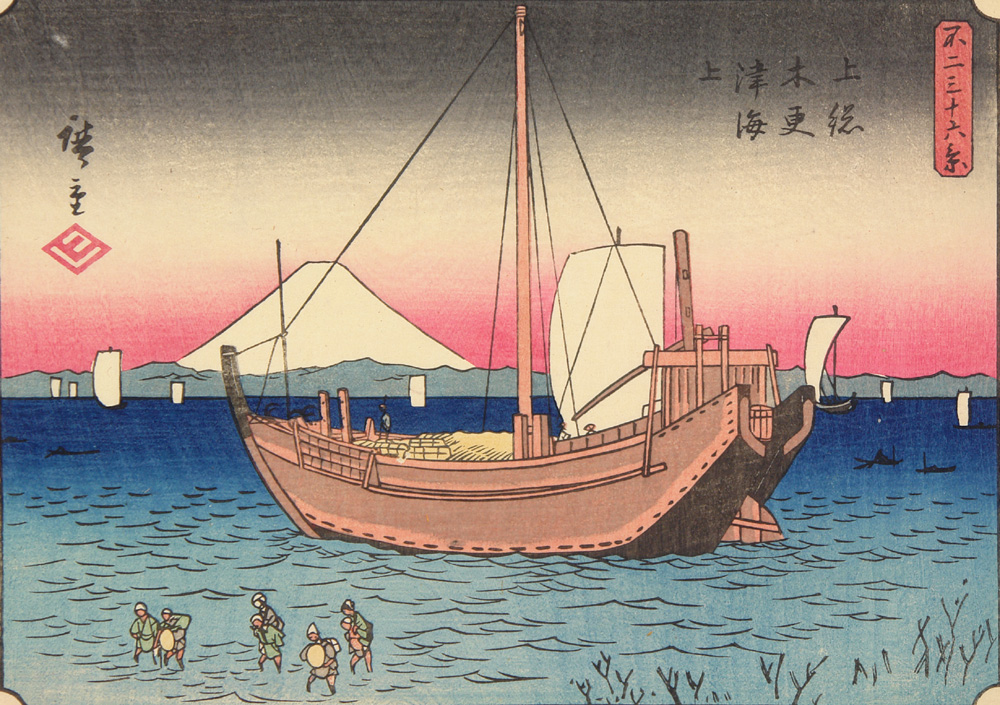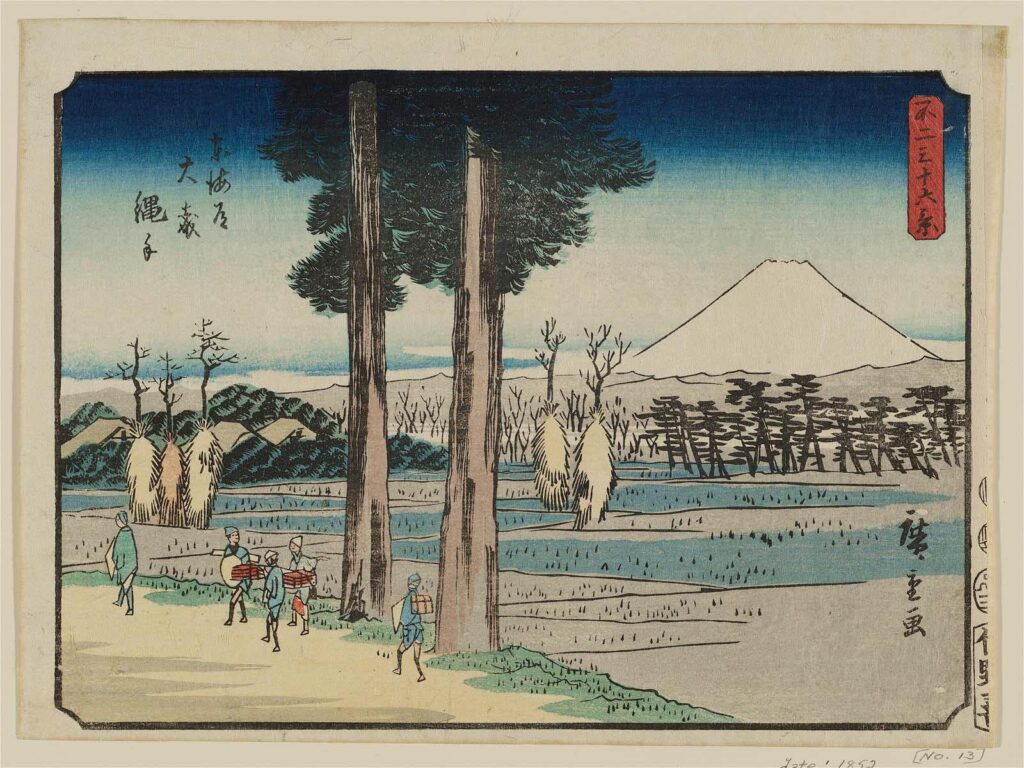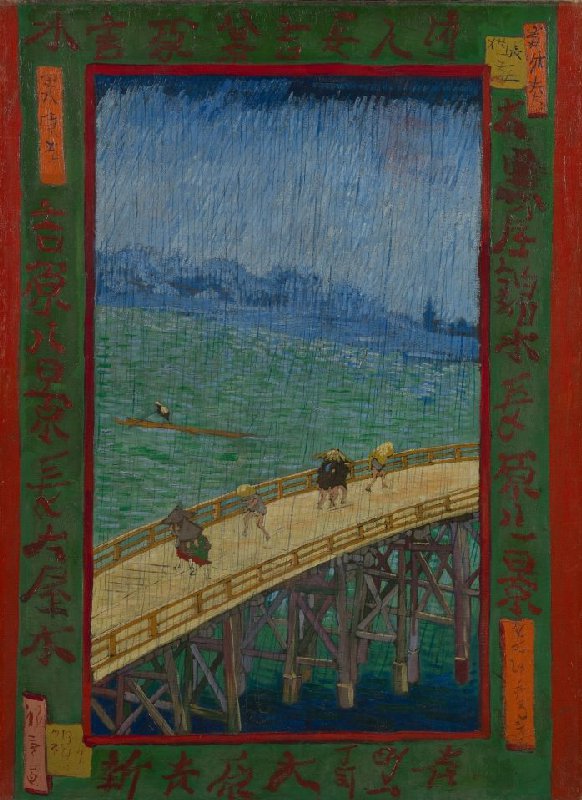Summary
- In the Edo period, Japan introduced reforms increasing the country’s safety which impacted art. With the expansion of the road network, tourism became popular. Luxury goods (including woodblock prints) were restricted which forced the publication of prints in smaller formats. The landscape painting began to flourish, fueled by the popularity of Hokusai’s series of views of Mount Fuji.
- Hiroshige’s series fit into an increasing popularity of printing series that served as travel books. The artist used original aesthetics and focused on everyday life and the passage of time.
- Hiroshige’s Thirty-Six Views of Mount Fuji was published in 1853. Unlike Hokusai, Hiroshige’s series used different planes, often placing the mountain on the horizon, and subtle and more atmospheric coloring based on natural dyes. The unusual perspective is one of the key elements and it is achieved through original framing, which conveys different moods, and the use of a negative space. The theme focuses not on Mount Fuji itself, but rather on the everyday life of people present in the scenes.
- The series was well received by the audience and Hiroshige created two more series on the same subject.
- Hiroshige’s work inspired European artists like Claude Monet and Vincent van Gogh.
- Thirty-Six Views of Mount Fuji represents Japanese yugen – a sense of the beauty of the universe.
The Development of Landscape Prints

Tsukioka Yoshitoshi, The Tokugawa Shogun Iemitsu Receiving Lords (Daimyo) in an Audience, 1875, Los Angeles County Museum of Art, Los Angeles, CA, USA. Britannica.
To fully understand the story of The Views, it is important to know a little bit about the political environment in Japan during the time in question. This era, known also as the Edo period (Edo being the name of the capital, current Tokyo), was marked by a significant number of reforms originally aimed to make Japan safer and more peaceful.
At this time, the feudal lords of Japan were unified under the rule of the Shogun. Westerners are more familiar with this period in the figure of the samurai, whose bravery and strict code of honor are legendary even in our day.
In the 1840s, a series of social reforms came into place with the purpose of addressing significant challenges in the areas of economy, society, and finance. Some of these changes deeply impacted the future course of Japanese art as we know it. One example is the expansion of the transit network to include checking stations along the main roads.
Hōrōheki Gives Rise to New Pastimes

Tourists at Kasuga Taisha Shrine in Nara Prefecture, Japan. Photograph by the author, 2023.
Initially, these stations were established to control the movement of military troops, but later expanded to accommodate the nobility and general traffic. Prior to this period, not many Japanese traveled for pleasure. Travel was expensive and unsafe. Afterwards, even though the roads were more accessible, travel was still highly regulated by the authorities. A traveler needed to show a Transit Permit at the checking station to be allowed to proceed.
With the increased traffic came the need for transport centers, rest stops, and inns, so little towns began springing along these routes. Now the common people also had access to the main roads and could watch the nobility as they traveled by. Even though their travel for pleasure was restricted, one form of travel became available to them: traveling for pilgrimage.
Perhaps people could not help themselves and the wanderlust was too strong. A way to translate this concept into Japanese is hōrōheki. Travelers who went on pilgrimage visited shrines to pray and give offerings. These people would not only pray, but also buy omiyage, or gifts, that could be talismans from shrines or temples, as well as food and gifts unique to the particular regions they visited. This tradition became so popular that it is still observed today! Travelers would take their time en route and stop at luxurious inns and onsen (hot springs).
Eventually, traveling on pilgrimage gave rise to tourist travel. When Japan closed its borders from the rest of the world, travel within the country was a way to satisfy people’s yearning to see different places.
Political Reforms Influencing Art

Kunisada Utagawa, Tozuka and Fujisawa – Yakusha Tokaido, private collection. Artelino.
By the mid-1800s, the shogunate as a system was ailing. In an effort to address declining morality and curbing luxury and excess, the shogun implemented the Tenpō Reforms. These laws targeted luxury items, social customs, and more importantly performing arts—particularly kabuki theaters and popular actors. This meant that the entertainment industry in major cities like Edo, Osaka, and Kyoto faced severe repercussions.
The year 1842 brought with it the most stringent restrictions on ukiyo-e, or woodblock prints. Censorship halted the production of traditional actor and courtesan prints because these could not be displayed. Multi-color book covers were banned, and other restrictions on books and prints came into effect. For example, multi-panel prints were limited to three sheets, and multi-color prints to only 8 blocks. As if these measures were not enough, the price for ukiyo-e was restricted to 16 mon, the lowest category.
These laws were a severe blow to an art that was incredibly specialized and time-consuming. To adapt, publishers began producing prints in smaller formats because they appeared less luxurious. Artists did their part by beginning to publish actor prints set against landscape scenery without naming the actors, relying instead on individual facial expressions for identification.
Art as a Response to Societal Change

Utagawa Hiroshige. Kiyomizu Hall and Shinobazu Pond at Ueno, No. 11 from 100 Famous Views of Edo, 1856. Brooklyn Museum, New York City, NY, USA.
Landscape painting began to flourish amid this environment. The rise of tourism and the restriction of permissible themes prompted artists to find different subjects. Hokusai and his Thirty-Six Views of Mount Fuji anticipated the worst of the reforms by a few years, with publication during the 1830s. The Japanese people are passionate about nature, and the series was a great success. Mount Fuji as a subject was an excellent choice, as it encapsulated Japanese spirituality and symbiosis with nature.
This series of prints revitalized the art of ukiyo-e during a time of censorship. They gave rise to landscape art and the depiction of daily life as a way to express beliefs and traditions that the Japanese held very dear. Other landscape series followed many different themes—the changing stations along the main roads, famous bridges, waterfalls, and different views of Edo (modern-day Tokyo). But Mount Fuji, as a subject, as a symbol of Japan, still could provide inspiration to another great artist who would make it his subject.
Utagawa Hiroshige

Utagawa Kunisada, Memorial Portrait of Utagawa Hiroshige, 1858, San Diego Museum of Art, San Diego, CA, USA.
Utagawa Hiroshige was born Andō Tokutarō, though he went through several name changes in his lifetime. He lived in the Yaesu area of Edo and was of samurai background. He became an orphan when he was 12, inheriting his father’s office as fire warden of Edo Castle. This job seems to have provided him with a lot of leisure time because, eventually, he began painting. He must have made good progress because, around age 15, he was allowed to sign his own works, which he did under the name Hiroshige.
At first, he trained with a traditional school influenced by Chinese and Buddhist traditions. After a while, economic reasons must have prompted him to seek a more lucrative trade to supplement his income as a fire warden. Realizing that the popularity of woodblock prints allowed him to use his skills while offering goods that people wanted, he became an apprentice at the Utagawa school. This was the largest school of ukiyo-e of this period.
During his apprenticeship, Hiroshige would have worked on book illustrations and single-sheet ukiyo-e of beautiful women and kabuki actors. Around the 1830s, he began to produce the landscapes that he would be known for later. Was he influenced by Hokusai’s prints from this period? Some of his best-known prints come from a series called The Fifty-Three Stations of the Tōkaidō, which was the route between Edo and Kyoto, and came as a result of a trip he took in 1832.
Hiroshige’s Unique, Intimate Style

Utagawa Hiroshige, Chiyo Point at Meguro in Edo, View No. 29 from the series Thirty-Six Views of Mount Fuji, 1852, Museum of Fine Arts Boston, Boston, MA, USA.
Prior to Hiroshige’s time, government restrictions upon art meant that most print series consisted of small sets of ten or twelve designs. As demand grew, and with the profit these sales brought, the series began to expand into large works such as The Sixty-Nine Stations of the Kisokaidō or One Hundred Famous Views of Edo.
Approaching the design of a series is much different than the conception of a single work of art. In this case, Japanese print-makers functioned much like designers who conceptualized a theme and then iterated on it throughout the different prints of the work. Hence the titles of the series, which are almost like curated lists of interesting points along a well-known road, or collections of views one should not miss. These functioned effectively as our travel books of today.
In Hiroshige’s case, his aesthetic developed also in a very distinct compositional direction. His unusual vantage points are particularly interesting, and the framing of his prints—almost photographic in its treatment of space—is both innovative and attractive. Here was an artist who was getting close-up with everyday life while hinting at the larger world. In the development of his series, he was also concerned with the passage of time. To this end, seasonal allusions and well-placed color helped him tell the story of the “trips” he invited his viewers to take with him.
Hiroshige’s Thirty-Six Views of Mount Fuji

Jocelyn Bouquillard, David Rocher, Hiroshige: Thirty-Six Views of Mount Fuji, Prestel, 2021. Photograph by the author.
We finally arrive at Hiroshige’s own homage to Mount Fuji. This series was published in 1853, echoing Hokusai’s earlier theme but with a style all his own. Even though the modern-day viewer might wonder why another series on Mount Fuji might be necessary, Hiroshige himself produced not only one, but three! Given that the pilgrimage to the sacred mountain had become almost a yearly summer ritual, travelers wished to bring back home images of places along the route. We can distinguish this first series from his second treatment on this subject by the landscape orientation of all the prints.
Hokusai’s treatment focused mostly on images of great energy and close-up views of Mount Fuji in all its magnificence. Hiroshige decided that he would, instead, depict the mountain on the horizon, incorporating different planes to convey an impression of field depth. Sometimes, the print would have the mountain as its only subject. At other times, Hiroshige would bring the focus to a few characters doing everyday activities, living in harmony with nature according to his Shintoist vision.
Hiroshige’s Tools

Utagawa Hiroshige, Sawtooth Mountain in Awa Province, View 1 of the series Thirty-Six Views of Mount Fuji, 1852. Museum of Fine Arts Boston, Boston, MA, USA.
Looking at Hiroshige’s oeuvre, and particularly at his work in the first Thirty-Six Views, we can distinguish several tools that he employed to compose his images. Taking into account that a woodblock print is a form of art with so many steps, Hiroshige’s artistry is on full display in these views. Some of these techniques are born from the medium. But, some of his compositional principles reveal an intelligent, very observant man who had arrived at the truth of what he wished to express as an artist.
At first glance, Hiroshige’s use of color is interesting and atmospheric, but also very intentional. While Hokusai was more bold, Hiroshige was subtle and almost romantic. To this effect, he printed with ultimate impressions in the same area and with extensive use of color gradation, which is a labor-intensive process that does not allow much room for error.
Hiroshige’s Colors
Hiroshige’s color palette was limited to natural sources whose dyes would produce pigment with fine particles. Some of the mineral pigments commonly used in paintings were too hard and were made of particles that were too large for ukiyo-e. As such, the ink could not penetrate well onto the block, nor adhere properly to the paper when printed, and they would have quickly worn down a woodblock.
Natural dyes produced from plants and insects were more suitable for ukiyo-e dyes because they were made of finer particles. Different parts of plants were used for the dyes, including leaves, petals, roots, and even grass and bark. Sometimes, synthetic colorants were used. The arrival—and novelty—of Prussian blue from the West gave ukiyo-e masters a new, fun tool for experimentation.
Among the different colors that Hiroshige favored are ochres, greens, and red ranging from pale pink to dark. Sections of white help depict snow, sea foam, and clouds.
Hiroshige’s Perspective
Perspective is not the first concept that comes to mind when thinking of Japanese woodblock prints, but Hiroshige uses it to great advantage in his work.
By employing techniques that help distinguish between background and foreground, Hiroshige is able to convey great depth and spatial relationships that are both interesting and emotionally engaging. He does this in several ways. Sometimes he uses gradation to convey distance. Other times, he uses framing to convey the illusion of depth. By including models in his compositions he is able to effectively illustrate dimension, scale, and size.
Hiroshige’s Framing
Framing is part of how Hiroshige portrays the idea of perspective, but his treatment is so clever that it deserves its own subtitle. Hiroshige’s framing is both a practical and aesthetic decision. He uses very interesting points of view to convey different moods and emotions. It all adds depth and visual interest while facilitating the hierarchy of the composition and the viewer’s reading of it. He does all this while imparting emotional qualities to each piece.
Sometimes the mountain looms large in the composition so that it comes out of frame, heightening the feeling of awe and otherworldliness at the presence of Mount Fuji. At other times, the viewer has to look hard to find the mountain because it has been lost in the distance. That, too, is experiencing Mount Fuji and bringing the feeling down to the people who live and work under its shadow. It is done with subtlety and elegance.
Hiroshige’s Negative Space
Because of his training with the Kanō school, Hiroshige had been trained to make use of negative space early on, and he does so to great effect in this series. Negative space sometimes suggests the mountain itself, sometimes it contributes to the atmosphere, the sky, or the clouds. Even though the landscape itself extends to the borders of the format, there is never a sense of clutter or distress in Hiroshige’s prints. There is lightness, elegance, timelessness, serenity, harmony, and balance despite the interesting framing.
There is visual interest everywhere, and Hiroshige achieves it through many different details. Unusual angles, the use of color to highlight and balance certain areas, and seasonal clues all connect the viewer to the general narrative of the series.
More than anything, all the prints in this collection hone in on an aspect of everyday life that the audience can identify with. Whether there are people viewing the cherry blossoms, or awaiting family at the harbor; whether they are having a picnic under the trees, or toiling up a road on pilgrimage—Hiroshige’s focus is not on the mountain itself as a symbol of awe and veneration. His focus is on the viewer’s relationship with this pervading presence.
Even though all things change, and the seasons pass, Mount Fuji is always there and that, in itself, is comforting and beautiful. The fact that Mount Fuji is actually a volcano only heightens this feeling of transient life and living in communion with a changing nature.
One Hundred Views of Mount Fuji
The audiences of Hiroshige’s time responded so favorably to his treatment of the theme that he worked on a second series released in 1858-1859, this time in a vertical format. He worked on yet a third series, One Hundred Views of Mount Fuji, which was interrupted due to his passing and released posthumously in black and white. It is fascinating to see how the same artist had still so much to say about this one subject—how the beauty and the immensity and even the transient nature of the world can provide such food for lifelong reflection and creativity.
Thirty-Six Views of Mount Fuji Goes Worldwide
Hiroshige’s work proved very inspirational, not only to his immediate audiences, but to artists in the West who could not get enough of these prints. Most famously, Vincent and Theo van Gogh loved, collected, and sold these prints at Theo’s gallery. Vincent van Gogh himself copied Hiroshige’s work to deconstruct it and find out how it worked, like a master study. The clever framing, interesting angles and format, use of space, the immortalization of everyday themes, all of these were techniques that were not popular in the art of the West during that time.
The Impressionists, particularly, were deeply influenced by these prints. Artists like Claude Monet or Henri Rivière borrowed the concept of a series of images devoted to a chosen theme. Monet’s famous Haystack series, or his Water Lilies, are just a couple of examples of an everyday object reinterpreted under different light, season, and perspective, to capture that fleeting feeling of a lived moment that is passed and will not come again.
Wabi, Sabi, and Yugen

Utagawa Hiroshige, The Sea at Honmoku in Musashi Province, View No. 36 from the series Thirty-Six Views of Mount Fuji, 1852, Museum of Fine Arts Boston, Boston, MA, USA.
Japanese aesthetics are very influenced by the Japanese spiritual life and the traditions of Shintoism and Buddhism. The triad of ideas formed by wabi, sabi, and yugen are concepts that have become integral to the Japanese philosophy and approach to daily life. Wabi is the idea of transient and stark beauty. Sabi is the natural beauty of aging. In the West, we have begun to hear about wabi-sabi as the beauty of imperfect, impermanent, incomplete things.
Yugen is the deep and mysterious sense of the beauty of the universe, and that is what Hiroshige has given us with these Thirty-Six Views of Mount Fuji. The opportunity to study one idea thoroughly through a series of prints, like reading a story, takes the viewer through all the scenes and all the feelings. Mount Fuji remains as we each go through our own journey. Whether it be pilgrimage, work, communal interaction, or the yearly cycle of seasons, every viewer can take something as his own.
In the final print, we see a ship on the high sea, land in the distance, and Mount Fuji looming over the composition. Whether the ship is coming to port, or leaving it all behind, there is beauty in all of it. Hiroshige’s work invites us to find it and to embrace it.






















